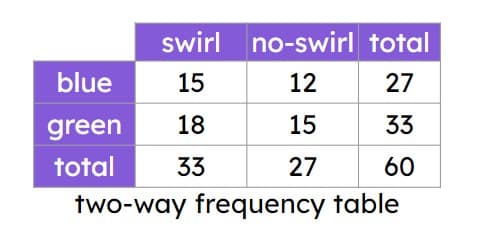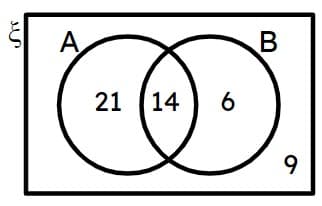Myths about teaching can hold you back


- Year 11•
- Higher
Conditional probability in a Venn diagram
I can calculate a conditional probability from a Venn diagram.


- Year 11•
- Higher
Conditional probability in a Venn diagram
I can calculate a conditional probability from a Venn diagram.
These resources will be removed by end of Summer Term 2025.
Switch to our new teaching resources now - designed by teachers and leading subject experts, and tested in classrooms.
These resources were created for remote use during the pandemic and are not designed for classroom teaching.
Lesson details
Key learning points
- A Venn diagram can be used to calculate conditional probabilities
- A Venn diagram can be used to calculate conditional probabilities involving sets of events
- Venn diagrams allow us to identify which events are mutually exclusive
- Venn diagrams can be used to identify which events are independent
Keywords
Venn diagram - Venn diagrams are a representation used to model statistical/probability questions. Commonly circles are used to represent events.
Probability - The probability that an event will occur is the proportion of times the event is expected to happen in a suitably large experiment.
Conditional probability - Conditional probability is the probability of an outcome occurring given that another event has occurred.
Independent events - Event A is independent of event B if the probability of event A occurring is not affected by whether or not event B occurs.
Mutually exclusive - Mutually exclusive events have no outcomes in common.
Common misconception
Pupils may confuse the probability of event A given B, P(A|B), with the probability of event A and B occurring.
Use the context of the question to make a judgement about what probability is to be calculated. Try to avoid using, or draw attention to, potentially ambiguous language/notation. E.g. Is P(AB) referring to P(A given B) or P(B given A) or P(A and B)?
To help you plan your year 11 maths lesson on: Conditional probability in a Venn diagram, download all teaching resources for free and adapt to suit your pupils' needs...
To help you plan your year 11 maths lesson on: Conditional probability in a Venn diagram, download all teaching resources for free and adapt to suit your pupils' needs.
The starter quiz will activate and check your pupils' prior knowledge, with versions available both with and without answers in PDF format.
We use learning cycles to break down learning into key concepts or ideas linked to the learning outcome. Each learning cycle features explanations with checks for understanding and practice tasks with feedback. All of this is found in our slide decks, ready for you to download and edit. The practice tasks are also available as printable worksheets and some lessons have additional materials with extra material you might need for teaching the lesson.
The assessment exit quiz will test your pupils' understanding of the key learning points.
Our video is a tool for planning, showing how other teachers might teach the lesson, offering helpful tips, modelled explanations and inspiration for your own delivery in the classroom. Plus, you can set it as homework or revision for pupils and keep their learning on track by sharing an online pupil version of this lesson.
Explore more key stage 4 maths lessons from the Conditional probability unit, dive into the full secondary maths curriculum, or learn more about lesson planning.

Licence
Prior knowledge starter quiz
6 Questions
Q1.Event A is of event B if the probability of event A occurring is not affected by whether or not event B occurs.
Q2.Select the example of events which are not independent.
Q3.The table shows the types of marble in a bag. Match each event to its probability.

P(blue) -
$$27\over 60$$
P(green) -
$$33\over 60$$
P(blue and has no swirl) -
$$12\over 60$$
P(blue given it has no swirl) -
$$12\over 27$$
P(green and has a swirl) -
$$18\over60$$
P(green given it has swirl) -
$$18\over 33$$
Q4.A marble is taken at random from a box of marbles. Alex works out that P(swirl given it is blue) = P(swirl). This shows the event 'has a swirl' is __________ of the event 'blue marble'.
Q5.A 10-sided die with integers from 1 to 10 written on it is rolled once. Select the pair of mutually exclusive events.
Q6.A deck of cards has a number on it (either prime or non-prime), and a symbol (a circle, square, or wave). A card is selected at random from the deck. Find P(non-prime | wave).

Assessment exit quiz
6 Questions
Q1.Event A and event B are mutually exclusive events. Which of these statements are correct?
Q2.From the frequency Venn diagram, P(A | B) = . Give your answer as a decimal.

Q3.From the frequency Venn diagram, P(A | B') = . Give your answer as a decimal.

Q4.The diagram shows the number of outcomes for two events A and B. The values of P(A | B) and P(A | B') show that events A and B are events.

Q5.Here is an incomplete frequency Venn diagram. P(C) = $$1\over3$$, P(D') = $$1\over6$$, P(C ∩ D) = $$1 \over 4$$ and P(C | D) = $$3 \over 10$$. The value of $$x$$ is .

Q6.Here is an incomplete frequency Venn diagram. P(C) = $$1\over3$$, P(D') = $$1\over6$$, P(C ∩ D) = $$1 \over 4$$ and P(C | D) = $$3 \over 10$$. The value of $$y$$ is .


